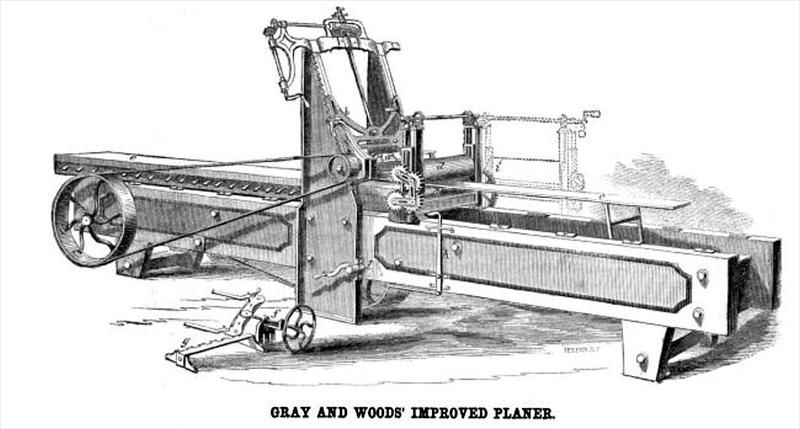|
Title: |
1860 Article-Gray & Woods, Improved Planer |
|
Source: |
Scientific American 04 Feb 1860 pg 88 |
|
Insert Date: |
11/25/2014 5:06:06 PM |
IMPROVED PLANER — This is a combination of two costly machines, the Daniels' planer and the Woodworth machine, in one; which can be built at an expense but a trifle more than either of the two.
Our illustration represents it arranged as a Woodworth planer; the revolving cutters, a, being hung in the sliding frame, 6, so that they may be raised or lowered according to the thickness to which the stuff is to be planed. The plank, c, is fed between the rollers, d d, which carry it along by their revolutions under the cutters. When it is desired to plane stuff out of wind, as is done with the Daniels' planer, the frame in which the rollers, d d, arc hung is swung round on a hinge out of the way, by the farther side of the machine, as shown by the dotted lines, and the bed, e, is brought into use. This bed being moved along to the right hand end of the machine, the dogs, f and g (seen loose in the cut), are fastened upon it, f at its right hand end and j at such place as will bring it at the opposite end of the stuff. The winding plank or other wood to be planed is dogged on the bed, and this being thrown into gear, is carried under the revolving cutters which reduce the surface of the plank to a plane from which it will not twist on being released from its hold. When the machine is thus arranged, stuff may be planed by it from ½ to 16 inches in thickness, and by removing the left hand dog, g, and introducing the small pressure roller, k, in front of the cutters, stuff may be planed as thin as 1-16th of an inch. The bed is carried along by a rack upon its under side which gears into a driving pinion, and the direction of this pinion's motion may be changed by means of the handle, h, so as to carry the bed both ways by the power of the engine. The gear which drives the pinion by which the bed is carried back and forth is on the shaft, l, and a series of gears on the further end of the same shaft, l, turns the rollers when they are in use and the machine is arranged as a Woodworth planer; a lever on the further side of the machine, not shown in the cut, serving to shift the feed gear either to the bed or to the rollers, as may be required. One distinct snbject of invention in this machine is the shape of the cutter-head, which is made concave from the edge of the cutters on the inner side, so as to operate like the double iron of the bench-plane to break the shaving and make smooth work in cross-grained hard wood. The crossbar of the dog, f, is pivoted in the middle, and the two arms are pivoted at its ends, thus adapting the dog to hold timber or plank the end of which is not at right angles with the length, or to hold two pieces of unequal length.
The object of these several combinations is the production of a machine practically adapted to the various kinds of shop work, such as carpentere' shop work, pattern making, pianoforte work, cabinet work, sash and door manufacturing, ship-carpentering, &c. It can be adapted to sticking, architraves, cornices, base moldings, and various other kinds of work.
It is protected by three patents: one issued Aug. 22, 1854; the second, Sept. 4, 1855; and the third, Jan. 24, 1860. The claims of the last patent may be found on another page. It received a silver medal at the last fair of the American Institute. This machine, with the recent improvements, can be seen in practical operation at Ross & Marshall's cabinet manufactory, corner of Eleventh-avenue and Twenty-ninth-street, and at John F. Cunningham's sash and door manufactory, corner of First-avenue and Twenty-seventh-street, this city.
For any further information in relation to this invention, inquiries may be addressed to Gray & Woods' machinery depot, No. 69 Sudbury Street, Boston, Mass.
US Patent: 26,902 |
|
 1860 Gray & Woods, Improved Planer
1860 Gray & Woods, Improved Planer
|
|